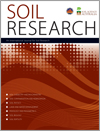Poly- and perfluoroalkyl substances (PFAS) are new persistent organic pollutants under the Stockholm Convention. Their extreme persistence is a cause of major concern. Products containing PFAS have been in use over the last 70 years in myriad applications (e.g. fire fighting foams, water-repellent textiles and packaging material) and this has resulted in widespread dispersal in the environment. Soil serves as a sink for PFAS. In this study we identify key properties that determine their mobility in the soil environment.
SR22183 Abstract | SR22183 Full Text | SR22183PDF (2.3 MB) Open Access Article





